1994 OLDSMOBILE SILHOUETTE engine
[x] Cancel search: enginePage 149 of 276
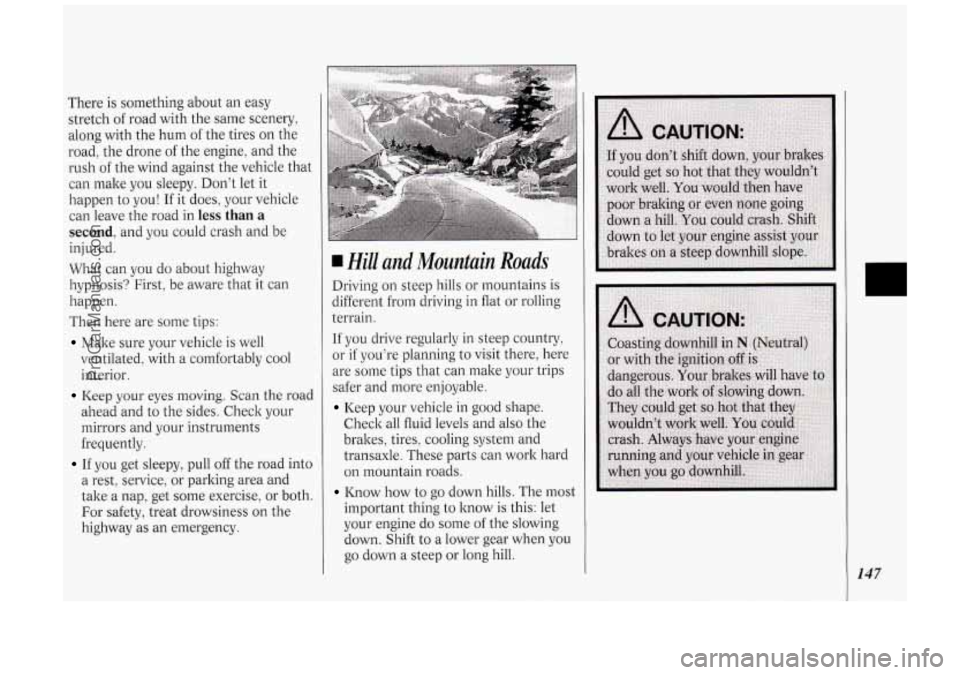
There is something about an easy
stretch
of road with the same scenery,
along with the hum
of the tires on the
road, the drone
of the engine, and the
rush
of the wind against the vehicle that
can make you sleepy. Don’t let it
happen to you!
If it does, your vehicle
can leave the road in
less than a
second, and you could crash and be
injured.
What can you do about highway
hypnosis? First, be aware that it can
happen.
Then here are some tips:
Make sure your vehicle is well
ventilated, with a comfortably cool
interior.
ahead and to the sides. Check your
mirrors and your instruments
frequently.
If you get sleepy, pull off the road into
a rest, service, or parking area and
take a nap, get some exercise, or both.
For safety, treat drowsiness on the
highway as an emergency.
Keep your eyes moving. Scan the road
I
Hill and Mountain Roads
Driving on steep hills or mountains is
different from driving in flat or rolling
terrain.
If you drive regularly in steep countly,
or if you’re planning to visit there, here
are some tips that can make your trips
safer and more enjoyable.
Keep your vehicle in good shape.
Check all fluid levels and also the
brakes, tires, cooling system and
transaxle. These parts can work hard
on mountain roads.
Know how to go down hills. The most
important thing to know
is this: let
your engine do some
of the slowing
down. Shift to a lower gear when you
go down a steep
or long hill.
147
ProCarManuals.com
Page 150 of 276
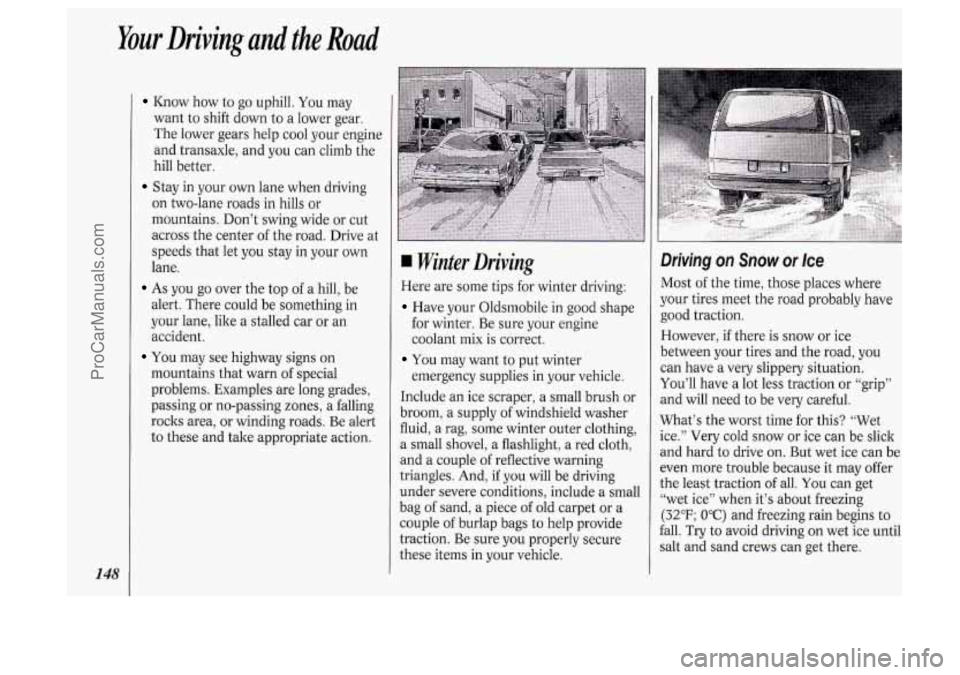
Your Driving and the Road
148
Ihow how to go uphill. You may
want to shift down to a lower gear.
The lower gears help cool your engine
and transaxle, and you can climb the
hill better.
Stay in your own lane when driving
on two-lane roads in hills or
mountains. Don’t swing wide or cut
across the center
of the road. Drive at
speeds that let you stay in your own
lane.
As you go over the top of a hill, be
alert. There could be something in
your lane, like a stalled car or an
accident.
You may see highway signs on
mountains that warn of special
problems. Examples are long grades,
passing or no-passing zones, a falling
rocks area, or winding roads. Be alert
to these and take appropriate action.
Winter Driving
Here are some tips for winter driving:
Have your Oldsmobile in good shape
for winter. Be sure your engine
coolant mix is correct.
You may want to put winter
emergency supplies in your vehicle.
Include an ice scraper, a small brush or
broom, a supply
of windshield washer
fluid,
a rag, some winter outer clothing,
a small shovel, a flashlight, a red cloth,
and a couple of reflective warning
triangles. And, if you will be driving
under severe conditions, include a small
bag of sand, a piece of old carpet or a
couple of burlap bags to help provide
traction. Be sure you properly secure
these items in your vehicle.
Driving on Snow or Ice
Most of the time, those places where
your tires meet the road probably have
good traction.
However,
if there is snow or ice
between your tires and the road, you
can have a very slippery situation.
You’ll have a lot less traction
or “grip”
and will need to be very careful.
What’s the worst time for this? “Wet
ice.” Very cold snow or ice can be slick
and hard to drive
on. But wet ice can be
even more trouble because it may offer
the least traction of all. You can get
“wet ice” when it’s about freezing
(32°F; O’C) and freezing rain begins to
fall. Try to avoid driving on wet ice until
salt and sand crews can get there.
ProCarManuals.com
Page 152 of 276
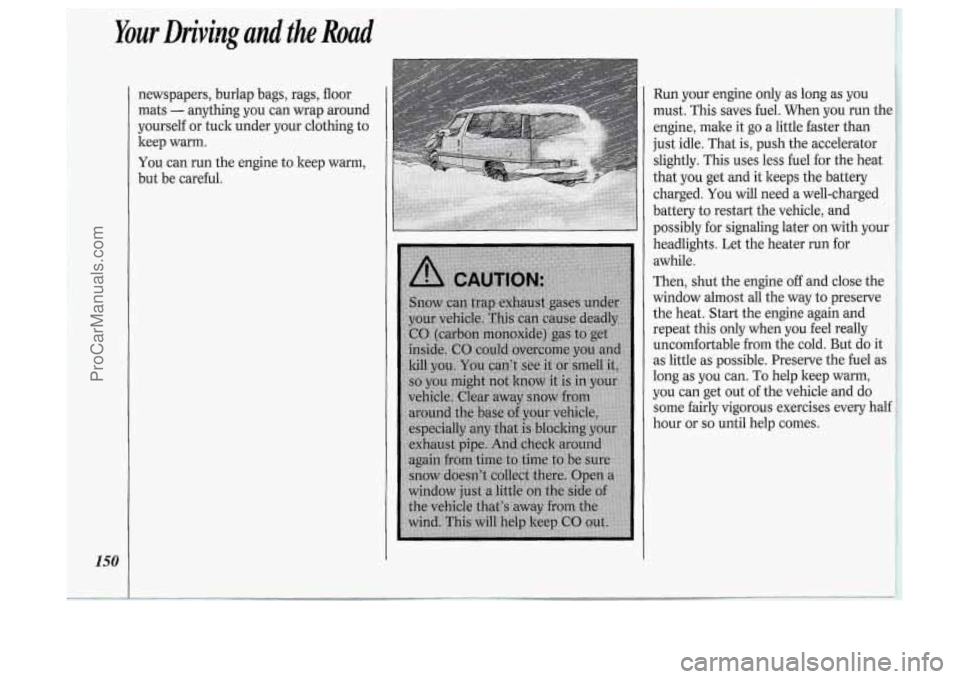
Your Driving and the Road
150
newspapers, burlap bags, rags, floor
mats
- anything you can wrap around
yourself or tuck under your clothing to
keep warm.
You can run the engine to keep warm,
but be careful. Run your engine
ody as long as you
must. This saves fuel. When you run the
engine, make it go a little faster than
just idle. That
is, push the accelerator
slightly. This uses less fuel for the heat
that you get and
it keeps the battery
charged.
You will need a well-charged
battery to restart the vehicle, and
possibly for signaling later on with your
headlights. Let the heater run for
awhile.
Then, shut the engine
off and close the
window almost
all the way to preserve
the heat. Start the engine again and
repeat this only when
you feel really
uncomfortable from the cold. But do it
as little as possible. Preserve the fuel as
long as you can.
To help keep warm,
you can get out of the vehicle and do
some fairly vigorous exercises every half
hour or
so until help comes.
ProCarManuals.com
Page 153 of 276
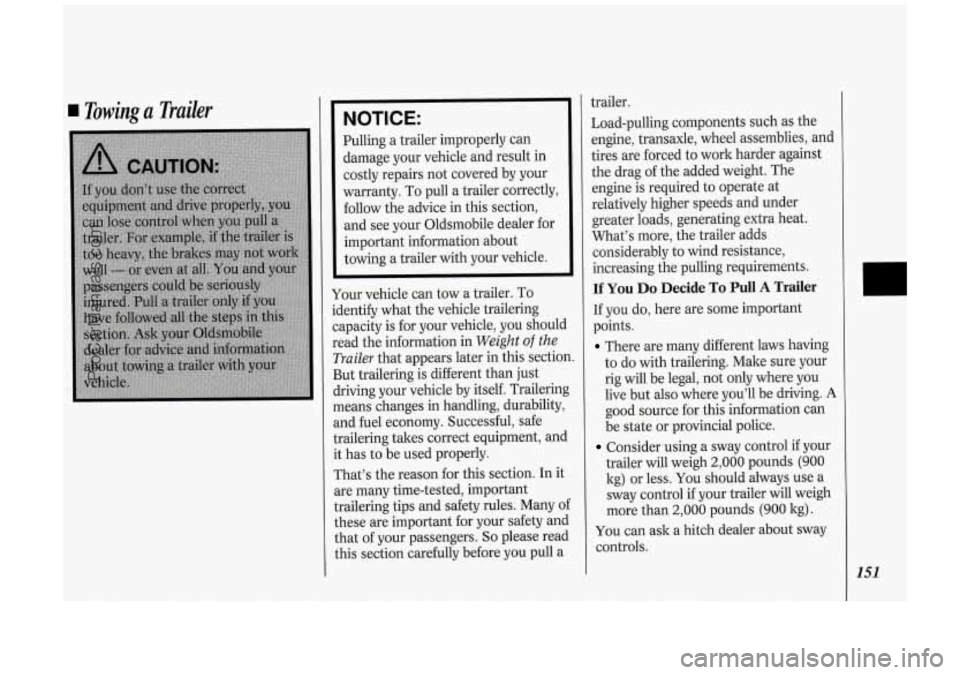
Towinga Trailer
L
NOTICE:
Pulling a trailer improperly can
damage your vehicle and result in
costly repairs not covered by your
warranty. To pull a trailer correctly,
follow the advice in this section,
and see your Oldsmobile dealer for
important information about
towing a trailer with your vehicle.
Your vehicle can tow a trailer. To
identify what the vehicle trailering
capacity is for your vehicle, you should
read the information in
Weight of the
Trailer that appears later in this section.
But trailering is different than just
driving your vehicle by itself. Trailering
means changes in handling, durability,
and fuel economy. Successful, safe
trailering takes correct equipment, and
it has to be used properly.
That’s the reason for this section. In it
are many time-tested, important
trailering tips and safety rules. Many of
these are important for your safety and
that of your passengers.
So please read
this section carefully before you pull a trailer.
Load-pulling components such as the
engine, transaxle, wheel assemblies, and
tires are forced to work harder against
the drag of the added weight. The
engine is required to operate at
relatively higher speeds and under
greater loads, generating extra heat.
What’s more, the trailer adds
considerably to wind resistance,
increasing the pulling requirements.
If You Do Decide To Pull A Trailer
If you do, here are some important
points.
There are many different laws having
to do with trailering. Make sure your
rig will be legal, not only where you
live but
also where you’ll be driving. A
good source for this information can
be state or provincial police.
Consider using a sway control if your
trailer will weigh
2,000 pounds (900
kg) or less. You should always use a
sway control if your trailer will weigh
more than
2,000 pounds (900 kg).
You can ask a hitch dealer about sway
controls.
151
ProCarManuals.com
Page 154 of 276
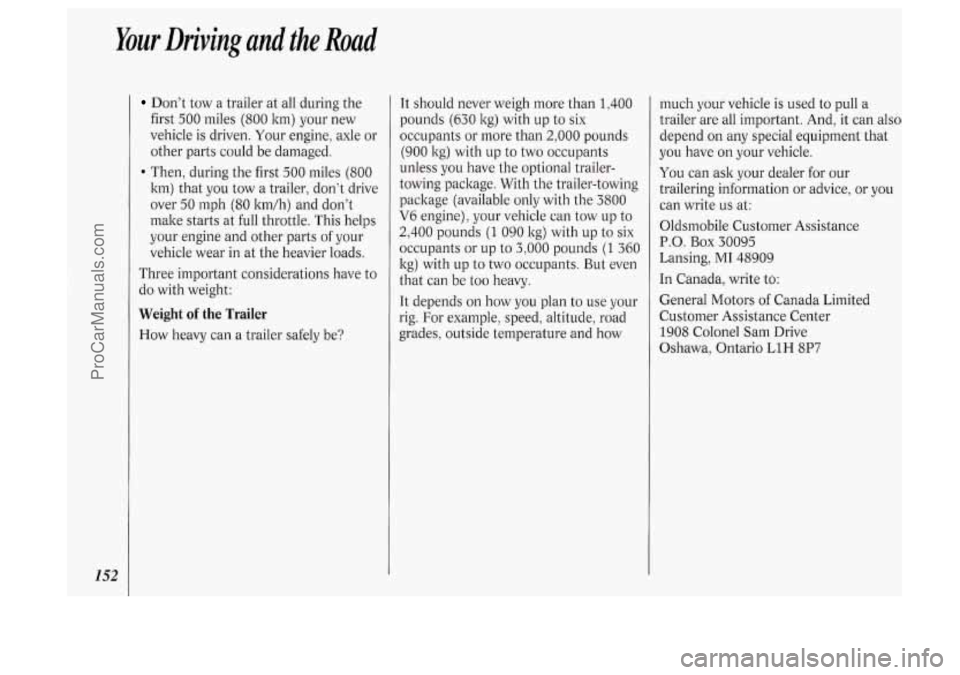
Your Driving and the Road
152
Don’t tow a trailer at all during the
first
500 miles (800 ltm) your new
vehicle is driven. Your engine, axle or
other parts could be damaged.
. Then, during the first 500 miles (800
km) that you tow a trailer, don’t drive
over
50 mph (80 lun/h) and don’t
make starts at full throttle. This helps
your engine and other parts of your
vehicle wear in at the heavier loads.
Three important considerations have to
do with weight:
Weight of the Trailer
How heavy can a trailer safely be? It should never
weigh more than 1,400
pounds (630 kg) with up to six
occupants or more than 2,000 pounds
(900 kg) with up to two occupants
unless you have the optional trailer-
towing package. With the trailer-towing
package (available only with the 3800
V6 engine), your vehicle can tow up to
2,400 pounds
(1 090 kg) with up to six
occupants or
up to 3,000 pounds (1 360
kg) with up to two occupants. But even
that can be too heavy.
It depends on how you plan
to use your
rig.
For example, speed, altitude, road
grades, outside temperature and how much
your vehicle is used to pull a
trailer are all important. And, it can also
depend
on any special equipment that
you have on your vehicle.
You can
ask your dealer for our
trailering information or advice, or you
can write
us at:
Oldsmobile Customer Assistance
P.O.
Box 30095
Lansing, MI 48909
In Canada, write to:
General Motors of Canada Limited
Customer Assistance Center 1908 Colonel Sam Drive
Oshawa, Ontario L1H 8P7
ProCarManuals.com
Page 155 of 276
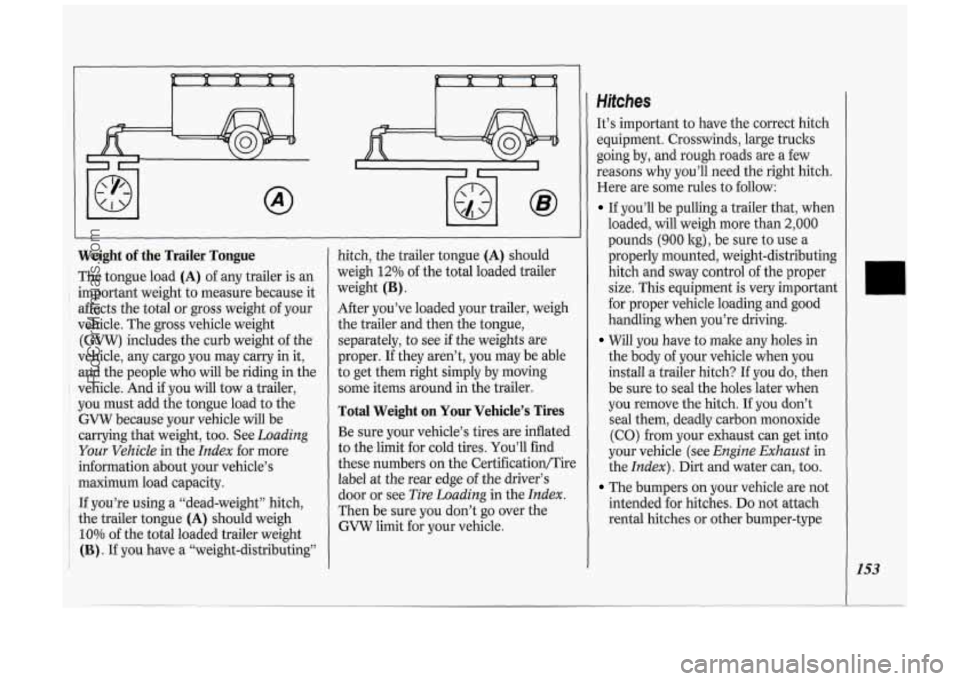
I
I I
Weight of the Trailer Tongue
The tongue load (A) of any trailer is an
important weight to measure because it
affects the total
or gross weight of your
vehicle. The
gross vehicle weight
(GVW) includes the curb weight of the
vehicle, any cargo you may carry in it,
and the people who will be riding in the
vehicle. And if you will tow a trailer,
you must add the tongue load to the
GVW because your vehicle will be
carrying that weight, too. See
Loading
Your Vehicle in the Index for more
information about your vehicle’s
maximum load capacity.
I If you’re using a “dead-weight’’ hitch, 1 the trailer tongue (A) should weigh
i 10% of the total loaded trailer weight
’ (B). If you have a “weight-distributing”
I
hitch, the trailer tongue (A) should
weigh
12% of the total loaded trailer
weight
(B) .
After you’ve loaded your trailer, weigh
the trailer and then the tongue,
separately, to see
if the weights are
proper. If they aren’t, you may be able
to get them right simply by moving
some items around in the trailer.
Total Weight on Your Vehicle’s Tires
Be sure your vehicle’s tires are inflated
to the limit for cold tires. You’ll find
these numbers on the Certification/Tire
label at the rear edge
of the driver’s
door or see
Tire Loading in the Index.
Then be sure you don’t go over the
GVW limit for your vehicle.
Hifches
It’s important to have the correct hitch
equipment. Crosswinds, large trucks
going by, and rough roads are a few
reasons why you’ll need the right hitch.
Here are some rules to follow:
If you’ll be pulling a trailer that, when
loaded, will weigh more than
2,000
pounds (900 kg), be sure to use a
properly mounted, weight-distributing
hitch and sway control of the proper
size. This equipment is very important
for proper vehicle loading and good
handling when you’re driving.
Will you have to make any holes in
the body of your vehicle when you
install a trailer hitch? If you do, then
be sure to seal the holes later when
you remove the hitch. If you don’t
seal them, deadly carbon monoxide
(CO) from your exhaust can get into
your vehicle (see
Engine Exhaust in
the
Index). Dirt and water can, too.
The bumpers on your vehicle are not
intended for hitches.
Do not attach
rental hitches or other bumper-type
153
ProCarManuals.com
Page 157 of 276
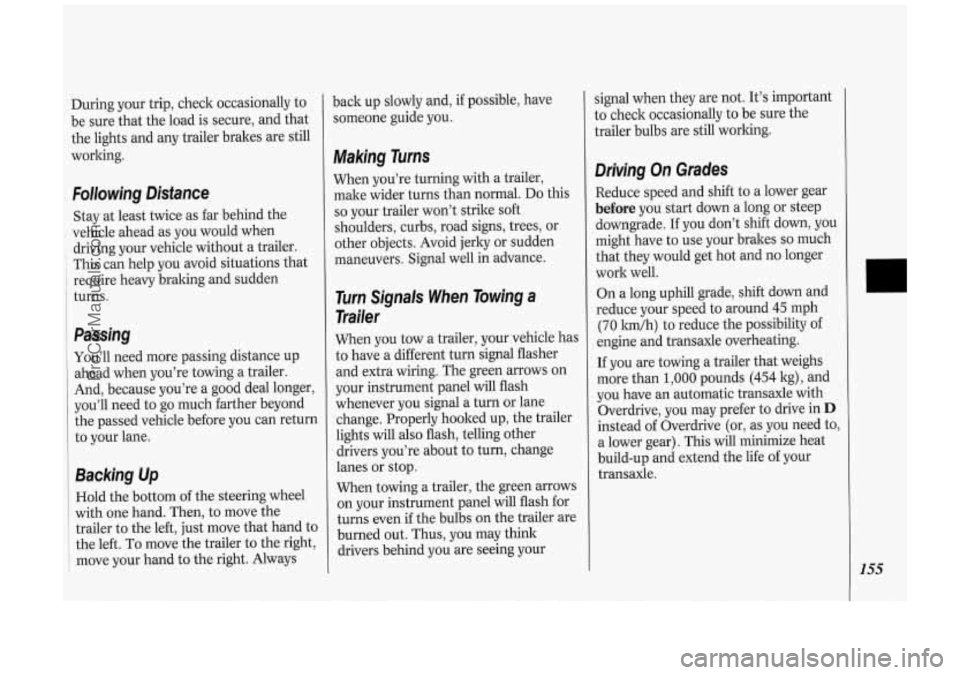
During your trip, check occasionally to
be sure that the load is secure, and that
the lights and
any trailer brakes are still
working.
Following Distance
Stay at least twice as far behind the
vehicle ahead as you would when
driving your vehicle without a trailer.
This can help you avoid situations that
require heavy braking and sudden
turns.
Passing
You’ll need more passing distance up
ahead when you’re towing a trailer.
And, because you’re a good deal longer,
you’ll need to go much farther beyond
the passed vehicle before you can return
to your lane.
Backing Up
Hold the bottom of the steering wheel
with one hand. Then, to move the
trailer to the left, just move that hand to
the left.
To move the trailer to the right,
move your hand to the right. Always back up
slowly and, if possible, have
someone guide you.
Making Turns
When you’re turning with a trailer,
make wider turns than normal. Do this
so your trailer won’t strike soft
shoulders, curbs, road signs, trees, or
other objects. Avoid jerky or sudden
maneuvers. Signal well in advance.
Turn Signals When Towing a
Trailer
When you tow a trailer, your vehicle has
to have a different turn signal flasher
and extra wiring. The green arrows on
your instrument panel will flash
whenever you signal a turn or lane
change. Properly hooked up, the trailer
lights will
also flash, telling other
drivers you’re about to turn, change
lanes or stop.
When towing a trailer, the green arrows
on your instrument panel will flash for
turns even
if the bulbs on the trailer are
burned out. Thus, you may think
drivers behind you are seeing your signal
when they are not.
It’s important
to check occasionally to be sure the
trailer bulbs are still working.
Driving On Grades
Reduce speed and shift to a lower gear
before you start down a long or steep
downgrade. If you don’t
shift down, you
might have to use your brakes
so much
that they would get hot and
no longer
work well.
On a long uphill grade, shift down and
reduce your speed to around
45 mph
(70 lwh) to reduce the possibility of
engine and transaxle overheating.
If you are towing a trailer that weighs
more than
1,000 pounds (454 kg), and
you have an automatic transaxle with
Overdrive, you may prefer to drive in
D
instead of Overdrive (or, as you need to,
a lower gear). This will minimize heat
build-up and extend the life of your
transaxle.
n
ProCarManuals.com
Page 158 of 276
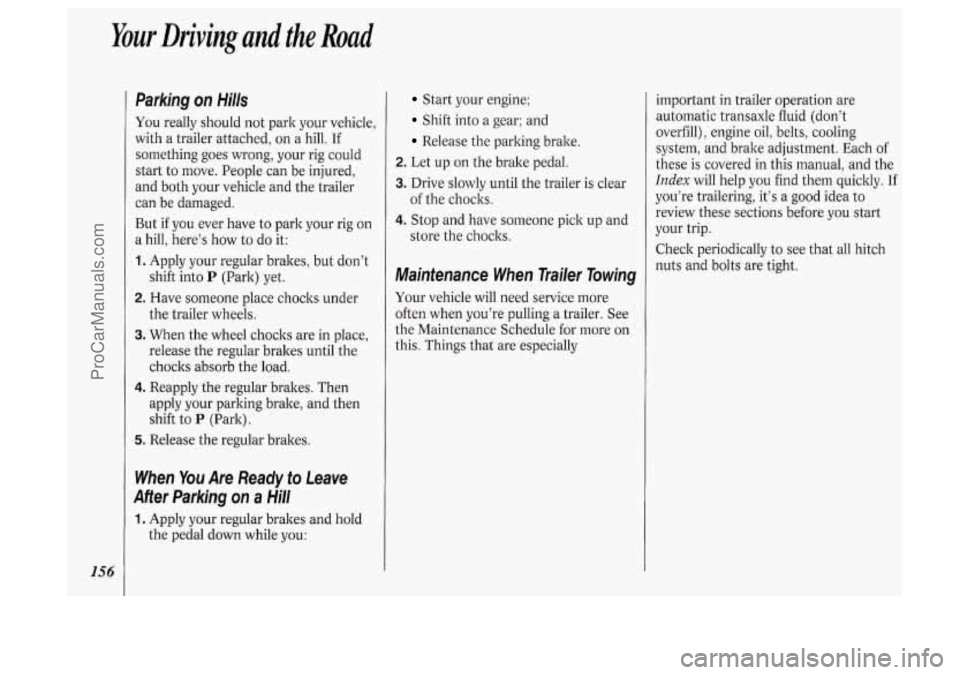
Your Driving and the Road
156
Parking on Hills
You really should not park your vehicle,
with a trailer attached, on a hill. If
something goes wrong, your rig could
start to move. People can be injured,
and both your vehicle and the trailer
can be damaged.
But
if you ever have to park your rig on
a hill, here’s how to do it:
1. Apply your regular brakes, but don’t
shift into
P (Park) yet.
2. Have someone place choclts under
the trailer wheels.
3. When the wheel chocks are in place,
release the regular brakes until the
chocks absorb the load.
apply your parking brake, and then
shift to
P (Park).
4. Reapply the regular brakes. Then
5. Release the regular brakes.
When You Are Ready to Leave
Affer Parking on a Hill
1. Apply your regular brakes and hold
the pedal down while
you:
Start your engine;
Shift into a gear; and
Release the parking brake.
2. Let up on the brake pedal.
3. Drive slowly until the trailer is clear
4. Stop and have someone pick up and
of
the chocks.
store the chocks.
Maintenance When Trailer Towing
Your vehicle will need service more
often when you’re pulling a trailer. See
the Maintenance Schedule
for more on
this. Things that are especially important in
trailer operation are
automatic transaxle fluid (don’t
overfill), engine oil, belts, cooling
system, and brake adjustment. Each of
these is covered in this manual, and the
Index will help you find them quicltly. If
you’re trailering, it’s a good idea to
review these sections before you start
your trip.
Check periodically to see that all hitch
nuts and bolts are tight.
ProCarManuals.com